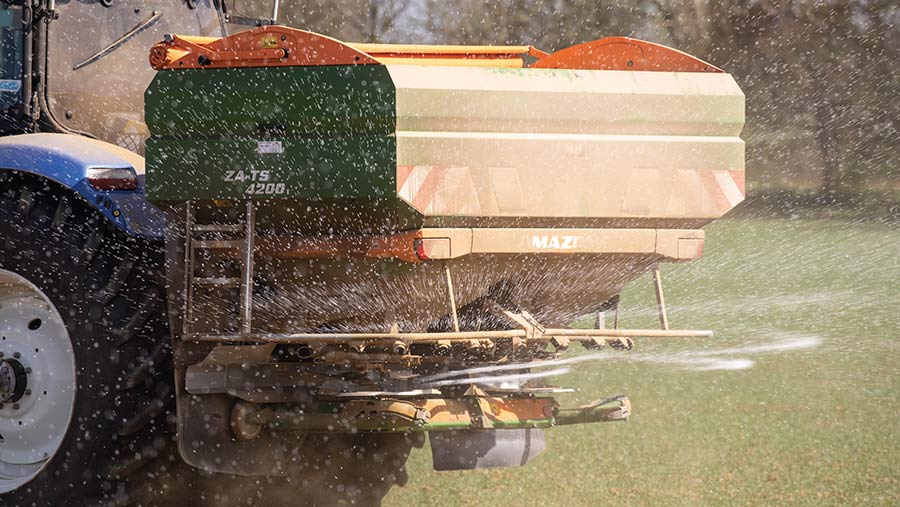The rules for arable farming in an NVZ in England
 © Tim Scrivener
© Tim Scrivener Nitrate vulnerable zones (NVZs) account for about 55% of land in England, making it more likely than not that a farming enterprise is within a designated NVZ.
So with NVZs falling into cross-compliance, what are the rules for arable enterprises in England and how do they affect crop nutrient management and organic manure storage?
Jo Oborn, south-west resource protection specialist at the Farming & Wildlife Advisory Group, looks into the rules for arable farms in NVZs.
See also: Guide to key cross-compliance dates for UK regions 2021
Do all farms need to comply with NVZ rules?
Not all farms fall within NVZs. But there are still rural payment schemes, government and public body rules and the farming rules for water that apply to all farms in England whether they are in a NVZ or not.
Who is responsible for NVZ compliance?
Whoever claims under the Basic Payment Scheme (BPS) and/or Rural Development Programme for England (RDPE) schemes such as Countryside Stewardship.
While work may be carried out by family members and staff, it is still the claimant’s responsibility to ensure rules are adhered to.
What about hired third parties?
When using third parties such as contractors and agronomists, liability will depend on the farmer or landowner’s actions; their choice of third party, instructions given, and monitoring.
Where can solid manures be stored?
Solid manures including farmyard manure, sludge and compost can be stored in a container, on an impermeable base where effluent must be collected and treated as slurry, in a roofed building, or, most commonly, in a temporary field heap.
What about slurry and poultry manure?
- Arable farmers using poultry manure must have sufficient storage from 1 October to 1 April. Poultry manure containing bedding or litter can be stored like a solid manure (see above).
- Those storing slurry before spreading must do so in accordance with both NVZ rules and legislation covering the storage of silage, slurry and agricultural fuel oil. There must be sufficient storage for a minimum of five months between 1 October and 1 March.
If constructing or enlarging storage facilities, farmers must follow the rules on storing silage, slurry and agricultural fuel oil.
Does a field heap have to be temporary and where can I put it?
The field heap must be moved at least every 12 months and the site left free for at least two years. Heaps should not be placed where there is risk of flooding or waterlogging and must:
- Be at least 10m from any inland freshwater and coastal water, including wetlands, ponds and dry ditches
- Be at least 10m from a land drain. If the land slopes at 12 degrees or more the distance increases to 30m
- Be at least 50m from a spring, well or borehole
- Be made from solid manure that is not leaking effluent and is dry enough to be stacked in a freestanding heap without risk of collapsing, ideally in a pyramid shape to reduce footprint
- If using straight poultry manure – not containing bedding or litter – a temporary field heap needs to be covered with a waterproof material.
Do any storage records need to be kept?
Yes, records need to be kept for five years.
This includes temporary field heap locations and dates of use. If recording on a spread risk map then it doesn’t need to be recorded separately elsewhere. Records for the previous year must be made by 30 April each year.
Low-risk areas that are earmarked for temporary field heaps must be marked on the spread risk map. If livestock are kept then the farmer or landowner must follow specific manure storage and record-keeping rules.
What counts as nitrogen fertiliser under the NVZ rules?
Manufactured fertilisers with nitrogen (N) content, organic manures and other materials containing N are all classed as N fertilisers and must be used following the NVZ rules. Organic manures that contain more than 30% immediately available N are classed as high readily available N manures.
How much nitrogen can be applied to crops?
The N-max limit (kg/ha) is the combined average of nitrogen from manufactured fertiliser and manure that can be applied to individual crops each year.
However, arable farmers have some flexibility and can apply additional N to specific crops if the expected yield is higher than the standard crop yield or additional N is required to meet crop quality requirements.
How much nitrogen from manure can be used?
The field limit is no more than 250kg/ha of total organic N in any 12-month period. This limit does not include manure deposited by grazing stock.
The farm limit is 170kg/ha; this applies as an average across the farm and includes N from livestock; consider this when importing manures or using grazing stock in rotations.
Organic farms must not spread more than 150kg/ha.
What must be done before spreading fertiliser and manure?
- Inspect fields to assess the risk of runoff and pollution. Look at sloping land, ground cover, distance to water sources, soil type and condition, and presence of land drains.
- Produce a spreading risk map identifying watercourses, non-spreading areas, high-risk areas, and field drainage status.
- Under the farming rules for water, soil test at least every five years; results must include pH, phosphorus, potassium and magnesium, and assess N status using soil nitrogen supply methods or soil minerals nitrogen testing.
- Work out the total and crop-available N in organic manures using the standard values table or results from sampling and analysis.
- Plan all N applications for every crop in every field. This includes calculating and recording the amount of crop-available N during the growing season; optimum N to be applied considering available soil N; the amount of crop-available N from manure spread in that season; and the amount of manufactured fertiliser needed.
- Consider weather conditions and forecasts.

© Tim Scrivener
When can’t fertilisers and manures be spread?
For manures with high readily available N, closed periods are:
- Sandy or shallow soils: 1 August to 31 December
- All other soils: 1 October to 31 January
- Exceptions for sandy or shallow soils: If a crop is sown on or before 15 September, applications can be made between 1 August and 15 September
- There are crop-specific exceptions for organic farms.
For manufactured fertilisers, closed periods are:
- 1 September to 15 January
- Exceptions: Some crops can have applications within the closed period, such as winter oilseed rape. Consult with a Facts-qualified consultant if in doubt
- For low intensity farms, check exemptions.
Where can’t fertilisers and manures be spread?
You must not spread:
- Manure within 10m of inland freshwater or coastal water
- Manure within 50m of a spring, well or borehole
- When using the right precision spreading equipment, slurry and anaerobic digestate can be reduced to no less than 6m from inland freshwater or coastal water
- Manufactured fertilisers or manure within 2m of inland freshwater, coastal waters, or within 2m of the centre of a hedge (GEAC1) (GAEC7a)
- When a field is waterlogged, flooded, covered in snow or has been frozen for more than 12 hours in a 24-hour period.
Are there exceptions for environmental schemes or sites of specific interest?
There are exceptions for land that is a site of specific scientific interest or managed under an agri-environmental scheme. Further details on exceptions can be found by checking rules and scheme agreements.
Are there rules about incorporating manures into soils?
Yes. Manures that are spread on to bare soil or stubble that has not been sown must be worked into the soil as soon as possible – within 24 hours for poultry manure and slurry, and all manures applied on sloping land within 50m of watercourses at risk of runoff.
Slurry applied using specific precision equipment does not have to be worked in.
Does the farmer/landowner have other pollution responsibilities?
They are responsible for taking reasonable action to reduce pollution risk. When using fertiliser and manure, this should include checking that spreading equipment is calibrated for quantity and spreading pattern, and not leaking.
Consider how to reduce soil erosion when spreading fertilisers and manures.
What spreading records need to be kept?
Keep a comprehensive fertilisation plan for each field.
Record and keep (for at least five years):
- Fertiliser and manure applications within one week of spreading
- Manufactured fertiliser applications, including amount of N spread
- Organic manure applications, including amount of crop-available N
- All brought-in livestock manure within one week, including N content whether through analysis or calculation
- N calculations, including written advice from Facts-qualified advisers
- Laboratory reports, sampling and analysis
- Yields of N-fertilised arable crops if above standard values
- Holding size
- A spreading risk map
- Defra has detailed steps for fertiliser planning and recording at Using nitrogen fertilisers in nitrate vulnerable zones.
NVZ rule summary
Farms within NVZs are required to comply with rules that are in place to limit and manage the use of N in order to reduce losses to the wider environment.
There are three key limits for arable farms without kept livestock:
- Whole farm organic N limit The upper limit on the amount of organic manure that can be imported
- Field limit The upper limit on the amount of organic N that can be applied on a field in a 12-month period
- Crop limit The upper limit of N that can be applied to specific crops in the cropping year. Closed periods prohibit applications of N at specified times of year when there is low crop requirement for N
Additional nitrogen allowance on specific arable crops |
|
|
Crops |
Additional N |
|
Wheat and barley |
An additional 20kg/ha for every tonne that exceeds standard yield |
|
Milling wheat |
An additional 40kg/ha |
|
Autumn/winter-sown wheat and barley |
On shallow soils – except over sandstone – an additional 20kg/ha |
|
Winter oilseed rape |
Up to 250kg/ha; this includes maximum autumn (closed period) application of 30kg/ha of manufactured fertiliser. If applying the additional nitrogen in the autumn, farmers can only use 220kg/ha in spring, unless the expected yield exceeds the standard yield, in which case an additional 30kg/ha is allowed for each exceeded tonne of yield |
Who enforces the rules?
The Rural Payments Agency (RPA) carries out cross-compliance inspections while the Environment Agency (EA) is responsible for enforcing the rules.
The NVZ rules are covered as a Statutory Management Requirement, outlined as SMR1 in the most recent guide to cross compliance in England.
BPS and RDPE payments are at risk of penalty for non-compliance, but early warning system letters may be issued without penalty.
Farmers and landowners are also at risk of prosecution and further fines by the EA if they put watercourses at risk or cause pollution.

